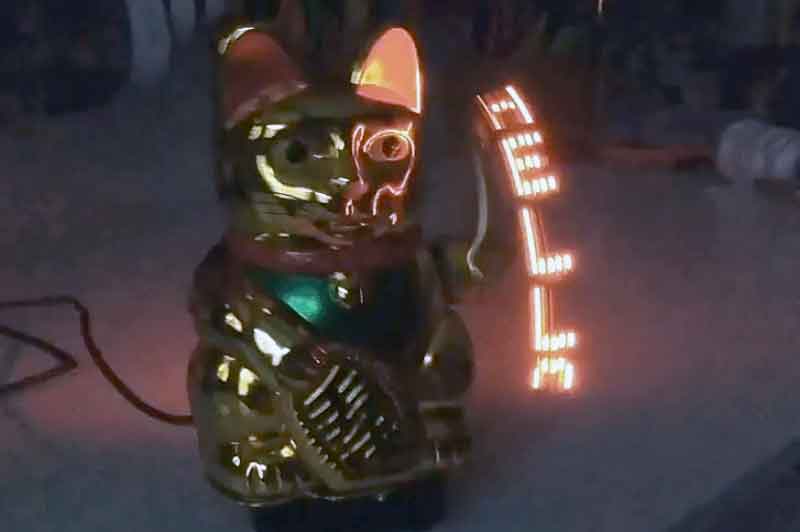If you’ve been in a Japanese restaurant, you’ve probably seen a maneki-neko, the lucky cat charm, where a cat welcomes you with a beckoning arm. It’s considered to bring good luck, but we’re not sure if [Martin Fitzpatrick] is pushing his luck with this Lucky Cat POV display. He hacked one of the figurines so the arm forms a persistence of vision (POV) display, where blinking LEDs on the paw create a dot-matrix style display.
Inside the hapless neko is a Wemos D1, motor driver, and a few other components that turn the cat into a working display. The five LEDs he attached to the paw are wide enough to display 5×7 characters. The tricky part in the mechanical design is getting signals from a stationary base to a spinning arm(ature). In this case it was easily solved with a 6-wire slip ring from Adafruit. [Martin] revs the lucky cat up using a brushed DC motor and a couple of gears.
The ESP8266 is running MicroPython — the combination should make this a snap to hook into any web service API you want to display your own messages. Right now the arm doesn’t have positional awareness so the message isn’t locked in a single position like it would be if a hall effect sensor was used. But [Martin] says there’s plenty of room left inside the cat and a future upgrade could include stashing the batteries inside for a cordless, all-in-one build. If he takes that on it’s a perfect time to add some type of shaft encoding as well.
Check the Lucky Cat showing off in the clip after the break.
[Via Reddit]















Fantastic
LOL, good idea!
Uh, -1, since it does not actually beckon anymore.
What if the display read “Come here”?
Nice project!
Maybe an easy way to add positional awareness, is to switch from the 5 LEDs to neopixles (but i am not sure if they could change fast enough for the PoV). But that would bring down the number of lines you need to three. Since the split-ring has 6 lines, you could make two cuts in one of the rings, feed it with Vcc and activate the integrated pull-down on the wemos.
Added benefit of the neopixels is that you can change the color and brightness as you please.
Also with the sense of position added, you could perhaps switch from the old waving behaviour of waving to message-spinning, perhaps by adding a PIR and doing so when somebody enters ;)
Neopixels (WS2812) are not very suitable as POV. You can use the (very similar) APA102 LEDs, they are also used in the “Magic Shifter 3000” POV device.
But I don’t see the connection between RGB LEDs and positional awareness. A position sensor does not need any active element on the moving arm. A small magnet (use the one from the “beckoning” mechanism) or a small piece of reflective tape are sufficient. The sensor can be stationary. Or you put the microcontroller (the MS 3000 uses an ESP8266) and the sensor on the moving part and need only two wires through the slipring for power supply.
I wonder if you even need a slipring for something that moves to and fro over around 30 degrees, although metal will eventually get fatigue I suppose, or would it?
EDIT: If you make cuts in the slipring, the contact piece could wear out very fast. I would use an optical or magnetic sensor.
Hello, kitty!
Nice writeup, great to see this here!
I can “sort of” get the image stationary by manually tweaking the PWM and vertical resolution. But any slip/stutter and it wobbles, plus it’s ridiculously inconsistent between runs. Using a hall-effect sensor for position tracking (to reset the display) is a great suggestion — thanks!